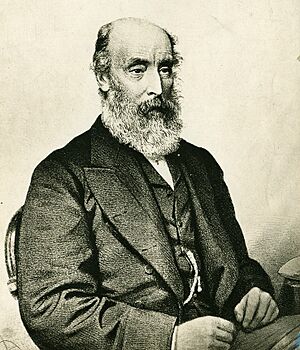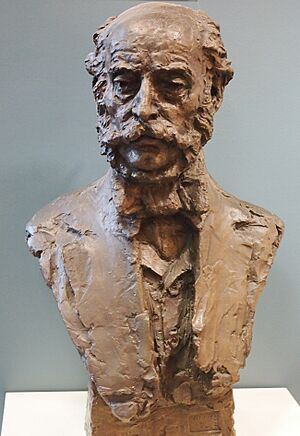Robert Richard Torrens facts for kids
Quick facts for kids
Sir Robert Torrens
|
|||||||||||||
|---|---|---|---|---|---|---|---|---|---|---|---|---|---|

Torrens in an 1880 illustration
|
|||||||||||||
| Premier of South Australia | |||||||||||||
| In office 1 September 1857 – 30 September 1857 |
|||||||||||||
| Monarch | Victoria | ||||||||||||
| Governor | Sir Richard MacDonnell | ||||||||||||
| Preceded by | John Baker | ||||||||||||
| Succeeded by | Richard Hanson | ||||||||||||
| Treasurer of South Australia | |||||||||||||
| In office 3 January 1852 – 21 August 1857 |
|||||||||||||
| Preceded by | B. T. Finniss | ||||||||||||
| Succeeded by | John Hart | ||||||||||||
| Member of the House of Assembly for the City of Adelaide |
|||||||||||||
| In office 3 March 1857 – 1 July 1858 |
|||||||||||||
| Preceded by | seat established | ||||||||||||
| Succeeded by | J.M. Solomon | ||||||||||||
| Member of the South Australian Legislative Council | |||||||||||||
| In office 21 February 1851 – 2 February 1857 |
|||||||||||||
|
|||||||||||||
| Personal details | |||||||||||||
| Born | 31 May 1812 Cork, Ireland, United Kingdom |
||||||||||||
| Died | 31 August 1884 (aged 72) Falmouth, Cornwall, England |
||||||||||||
| Nationality | British | ||||||||||||
| Political party | Liberal | ||||||||||||
| Spouse | Barbara Anson (née) Park | ||||||||||||
| Parents | Robert Torrens and Charity Herbert (née) Chute | ||||||||||||
| Alma mater | Trinity College, Dublin | ||||||||||||
Sir Robert Richard Torrens (born 31 May 1812 – died 31 August 1884) was an important person in politics and land reform. He was born in Ireland and later moved to London in 1836. He became famous in the early days of the Colony of South Australia after moving there in 1840.
He served as the Colonial Treasurer and Registrar-General from 1852 to 1857. For one month in September 1857, he was the third Premier of South Australia.
Torrens is best known for creating the Torrens title. This is a new way to register land ownership. It quickly spread to other Australian colonies and is now used in many countries worldwide. He made sure it was put into practice in South Australia in 1858. After returning to England in 1865, he was a member of the British House of Commons from 1868 to 1874.
His father, Robert Torrens, was an economist. He was also the chairman of the South Australian Colonisation Commission. This group helped set up and encourage people to move to the new colony.
Contents
Early Life and Education
Robert Torrens was born in Cork, Ireland, on 31 May 1812. He was the only son of Robert Torrens and his first wife, Charity Herbert.
He studied at Trinity College, Dublin, and earned his Bachelor of Arts degree in 1835. His father was in charge of the group that set up the new colony of South Australia. In 1836, Robert moved to London to work with his father. He learned about collecting customs duties, which helped fund the new colony. They also encouraged people from Ireland to invest and move there.
In 1839, he married Barbara Anson. She was the daughter of Alexander Park. In the same year, he earned his Master of Arts degree.
Life in South Australia
In December 1840, Robert and Barbara arrived in South Australia. In February 1841, Torrens became the Collector of Customs in Adelaide. He worked as a customs official until 1852. This job helped him learn a lot about buying and selling ships and their parts.
He was known for doing things his own way in official matters. He sometimes had disagreements with shipowners. However, these issues did not stop him from getting other important jobs.
In 1851, he was chosen to be one of the four official members of the South Australian Legislative Council. In 1852, he became the Colonial Treasurer, a job he held until 1862. He also became the Registrar-General of Deeds, which was one of the highest-paying jobs in Australia.
South Australia became a self-governing colony in 1856. This meant it could make its own laws. Torrens became the Treasurer of South Australia from October 1856 to August 1857. During this time, he started to share his ideas for land reform.
He also volunteered in the colonial artillery for 11 years. He retired as a Lieutenant-Colonel in 1865.
Torrens first disagreed with the idea of voting by secret ballot. But after seeing how well it worked in South Australia in 1856–1857, he changed his mind. He said it was "the best and most rapid" way to hold elections.
The Torrens Title System
In 1857, Torrens was elected to the South Australian House of Assembly for the City of Adelaide. On 1 September 1857, he became Premier, but his government only lasted one month.
For many years, he had strongly pushed for changes to how land ownership was recorded. The old system of transferring land by deed was slow, costly, and not very safe. It used long, complex documents that had to be kept for a century to prove ownership. Lawyers were always needed for these deals.
Torrens introduced a bill to change this. Even with strong opposition, it passed both houses of parliament on 27 January 1858.
The Real Property Act 1858
The Real Property Act 1858 was approved on 27 January 1858. Its goal was to make land transfers simpler.
The Act started on 2 July 1858 and was mostly well-received. Some lawyers were not happy, as the new, simpler process meant less money for them. Torrens left his job in parliament and was made Registrar-General. In this role, he helped make sure the new system was put into practice smoothly.
The Act completely changed how land ownership was recorded. Instead of old deeds, the government issued certificates. A central register was set up to keep track of all land titles. This system meant that land was transferred by registering the title, not by using deeds.
This new system created a clear and undeniable record of ownership. It almost stopped legal fights over land. It also solved problems caused by lost certificates and made buying and selling land much cheaper. The law was improved over the next few years. One change allowed licensed land brokers, not just lawyers, to handle land deals, which lowered costs even more.
How the System Spread
The Torrens title system was so successful that it was adopted across Australia and in many other countries. It became known as the Torrens title.
Torrens visited Victoria in 1860 and helped them start the new system. He also helped other colonies in Australia, like Queensland and New South Wales, use their own versions of the system. New Zealand, Malaysia, and some states in the US also adopted it. Since then, it has been used widely around the world.
In 1862, Torrens published a book called A handy book on the Real Property Act of South Australia. It explained the new system. In South Australia, the Act was updated in 1886. The Real Property Act 1886 (with later changes) is still the main law for property in South Australia today.
Who Gets the Credit?
Some people have questioned if Torrens alone should get all the credit for the new system. It has been suggested that Anthony Forster, a newspaper editor, first suggested the idea.
However, Torrens wrote in his book that he became interested in land reform 22 years earlier because of problems faced by a relative. He said he had been working on the problem for many years. He also mentioned that his idea was based on how shipping property was transferred. He learned about this as a customs official in London and Adelaide from 1836 to 1852.
His experience as Registrar-General, being a landowner himself, and the ideas of other politicians and lawyers also influenced him.
Torrens also knew about a report from 1857 by Ulrich Hübbe, a lawyer from Clare, South Australia. Hübbe knew a lot about land laws in German cities. His ideas helped make the new system practical in law. Torrens worked on these ideas further. With support from the German community, he fought for the bill in Parliament, even though many lawyers were against it.
Most sources agree that the new system worked so well in South Australia largely because of Torrens' careful planning and attention to detail.
Later Life and Legacy
In 1863, Torrens retired and moved back to England. He gave talks and worked to get land title laws put into place, especially in Ireland.
He became a member of the House of Commons for Cambridge from 1868 to 1874. However, he did not get the chance to make the land reforms he wanted in England.
He was honored with important titles for his work on land registration. He became a Knight Commander in 1872 and a Knight Grand Cross in 1884. Parliaments in Queensland, New South Wales, Victoria, and Tasmania thanked him for his work. However, in South Australia, a proposal to give him a pension was strongly rejected by some people who still had disagreements with him.
He died from pneumonia in Falmouth on 31 August 1884, at the age of 70. He was buried at Leusdon Churchyard with his wife, who died in 1899. There is no record of him having children.
Legacy
Torrens' most important legacy is the major legal change known as the Torrens title. This system was a world-first, created in Australia.
Many places are named after him:
- The Adelaide suburb Torrens Park, named after the home he built in 1853–4. This house is now part of Scotch College.
- Torrens Building in Adelaide.
- The Australia-wide Torrens University started in the Torrens Building.
- The Electoral district of Torrens.
- The Canberra suburb of Torrens.
- Torrens Terrace, a street in Wellington, New Zealand.
- Torrens Creek, Queensland, named by explorer William Landsborough in 1862.
(Note: Places named after his father, Robert Torrens, include the River Torrens, Torrensville, Lake Torrens, and Torrens Island.)
There is a portrait of Torrens in the Art Gallery of South Australia. A drawing of him is in the South Australian State Archives. There is also a bust of him by sculptor John Dowie. It was made to celebrate the world's first Torrens System of land titles in South Australia in 1858.
Political Roles and Offices
| Assembly seats | ||
|---|---|---|
| Preceded by Thomas O'Halloran Charles Sturt |
Member of the South Australian Legislative Council 1851–1857 Served alongside: Multiple Members |
Succeeded by Henry Ayers Charles Davies Charles Everard Thomas O'Halloran Abraham Scott |
| New district | Member of Parliament for City of Adelaide 1857–1858 Served alongside: Richard Hanson, Francis Dutton, Boyle Finniss, John Neales, William Burford |
Succeeded by Judah Solomon |
| Political offices | ||
| Preceded by James MacDonald |
Treasurer of South Australia 1856–1857 |
Succeeded by John Hart |
| Preceded by John Baker |
Premier of South Australia 1857 |
Succeeded by Richard Hanson |
| Chief Secretary of South Australia 1857 |
Succeeded by William Younghusband |
|
| Parliament of the United Kingdom (1801–present) | ||
| Preceded by John Eldon Gorst Francis Powell |
Member of Parliament for Cambridge 1868–1874 |
Succeeded by Patrick Smollett Alfred Marten |


